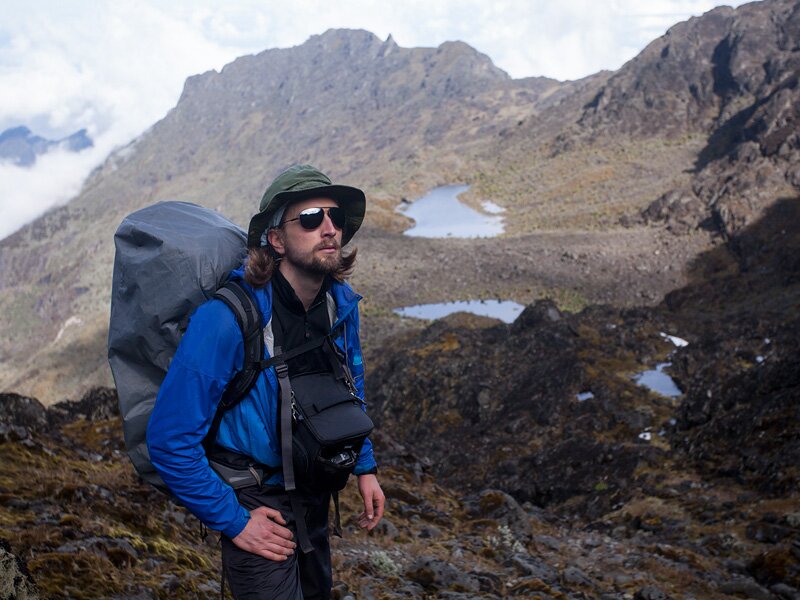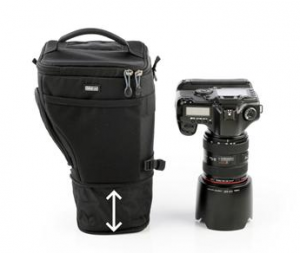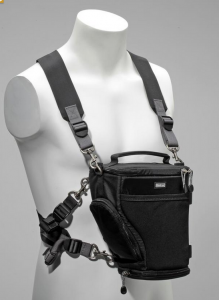For Christmas this year, my wife Liz got me the Think Tank Digital Holster™ 40 v2.0 and the Digital Holster™ Harness v2.0. I knew that the first months of 2013 would involve some adventurous photo and video expeditions, and I wanted a solution that would keep my camera close at hand, but also keep both of my hands free. Since I knew I’d be visiting the Rwenzori Mountains and the Solomon Islands, two very rainy places, I also wanted a solution that would keep my camera protected from the elements (this ruled out some popular camera carrying devices like the Cotton Carrier).

Here I am with the Digital Holster and Harness system, during our ascent of Mt. Speke. Photo by Nate Dappen.
So, now that we’re back from the Rwenzoris, how did the Digital Holster™ fare? Well, overall I was very glad that I brought the Digital Holster™ and Harness combination on this expedition. Here’s what I liked about it:
1) The Holster: The “Holster” itself is a solid little bag (not surprisingly for Think Tank, the build quality is excellent). Even though I shoot with a 5D Mark II and a 7D body, I opted for the Digital Holster™ 40 (which is designed to accommodate a full-sized pro SLR), because I like to leave my Really Right Stuff L-plates attached to my cameras at all times, and these make the camera body a bit bigger. I didn’t regret getting the larger holster (the other option was the Digital Holster™ 20). As it was, there wasn’t an abundance of extra room in the holster, and I’m not sure the 20 would have comfortably fit my camera with a 70-200mm f/2.8 lens and the lens foot attached. Oh, and the zip-out extension for longer lenses is really convenient, accommodating my 70-200mm f/2.8 lens (with the hood reversed) with a bit of room to spare, but collapsing to a smaller size when I wasn’t carrying the big lens. When I wasn’t using the chest harness, the holster provided enough protection for my camera that I was confident stuffing the whole thing in my backpacking pack while we were climbing some of the bigger peaks.
2) The Harness: The Harness was very comfortable, distributing the weight of the bag evenly across my shoulders. Even when I was carrying the 5D Mark II and 70-200mm lens, the whole setup was quite comfortable, which was important since I was climbing mountains most of the day. I also appreciated the low profile of the straps – instead of cushioning the load with bulky padding, they spread the weight of your camera across your shoulders with wide, thin straps that even have breathable mesh in the back so you don’t get too sweaty under them. The harness attaches to the Holster with a system of six straps that’s a bit complicated and definitely confusing at first. But once you get the hang of it, it’s pretty easy to get on and off, and the harness holds the holster very securely against your chest.

Digital Holster™ 40 v2.0. Photo from Think Tank.
3) Bells and whistles: The Digital Holster™ has some nice extra features, the kind of details I’ve enjoyed in other Think Tank products that I’ve used. It’s got a nice integrated rain cover, which I used on several occasions in the Rwenzoris. My camera never got wet. There are a couple of nice little pockets, one outside and one inside the lid (I used the inside pocket for memory cards and batteries). There’s also a nice stretchy pocket on the front of the holster (the side away from your chest), which I often used to carry accessories like a Rode Videomic. There’s a nice attachment that allows you to attach the holster to a belt, and some accessory straps where you could attach an extra lens pouch or something on the outside of the holster.
Overall, I was very happy with the Digital Holster™ 40 v2.0 and the Digital Holster™ Harness system. That being said, there are a few small things that could be improved.
1) When the Holster is perched on your chest, the lid opens away from you (which is good), but this makes the zipper somewhat tricky to access against your chest when it’s fully closed, especially if you’re wearing gloves. I’m not sure what the best solution to this issue would be, but I didn’t find the zipper placement to be ideal for quick access to the camera.
2) The attachment points for 4 of the 6 straps of the harness are very small webbing loops, and it was sometimes difficult (especially with cold hands or gloves) to connect the clips of the harness to these little loops on the holster. Once connected, however, I didn’t have any doubt that they would stay connected. Rather than deformable webbing loops, maybe small metal D-rings or something would make donning and removing the harness quicker.
3) While I used the rain cover several times, and it did a pretty good job staying on the holster, I think some kind of attachment (maybe Velcro or a snap closure) to secure the top of the rain cover to the top / rear of the Holster (i.e. the top of the side of the Holster that rests against your chest) would make the rain cover more secure.

Digital Holster™ Harness v2.0. Photo from Think Tank.
Finally, one limitation of the bag that is not a shortcoming of engineering, but simply an unavoidable consequence of this kind of bag: I found that once we got into really gnarly terrain, where I needed to use my hands and feet to climb, I really didn’t want the camera on my chest any more. On steep rocks, your instinct is to keep your center of mass as close to the rocks as you can, so you just don’t want something like an SLR in between you and the surface you’re clinging to. When we were climbing rocks, I put the holster in my backpack, and I was much happier that way.
To summarize, I think the Think Tank Digital Holster™ 40 v2.0 and Digital Holster™ Harness make a great camera-carrying solution for backcountry trekking. The build quality, degree of gear protection, and level of comfort are all excellent. In my case, I used the Digital Holster™ to keep my most-used camera and lens readily accessible on the trail, while I kept other, less frequently used items in a larger photo backpack. Despite a few minor shortcomings, I will take this combination with me – without hesitation – the next time I’m on a photo expedition that requires extended hiking in challenging terrain.

